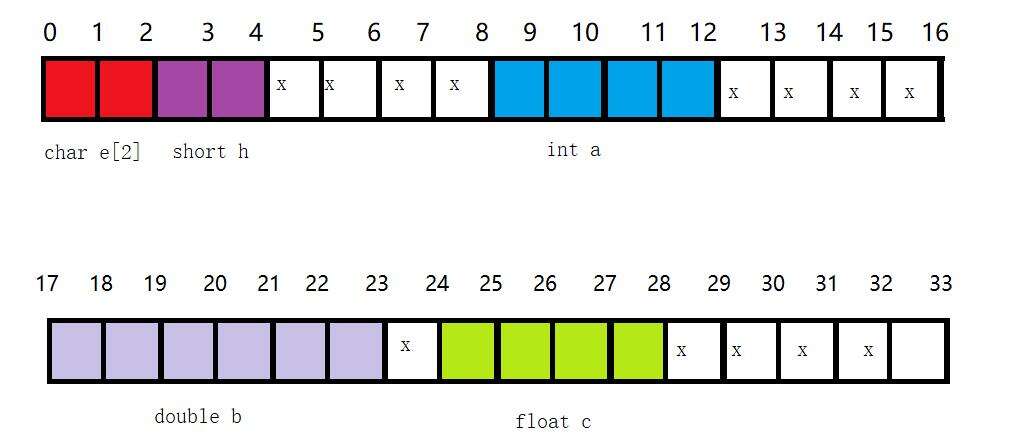【C语言】字节对齐(内存对齐)

1. 对齐原则:
【原则1】数据成员对齐规则:结构(struct)(或联合(union))的数据成员,第一个数据成员放在offset为0的地方,以后每个数据成员的对齐按照#pragma pack指定的数值和这个数据成员自身长度中,比较小的那个进行。
【原则2】结构(或联合)的整体对齐规则:在数据成员完成各自对齐之后,结构(或联合)本身也要进行对齐,对齐将按照#pragma pack指定的数值和结构(或联合)最大数据成员长度中,比较小的那个进行。
【原则3】结构体作为成员:如果一个结构里有某些结构体成员,则结构体成员要从其内部最大元素大小的整数倍地址开始存储。
备注:数组成员按长度按数组类型长度计算,如char t[9],在第1步中数据自身长度按1算,累加结构体时长度为9;第2步中,找最大数据长度时,如果结构体T有复杂类型成员A,该A成员的长度为该复杂类型成员A的最大成员长度。
小结:当#pragma pack的n值等于或超过所有数据成员长度的时候,这个n值的大小将不产生任何效果。
【注意】(对齐位数跟处理器位数和编译器都有关)VS, VC等编译器默认是#pragma pack(8),所以测试我们的规则会正常;注意gcc默认是#pragma pack(4),并且gcc只支持1,2,4对齐。套用三原则里计算的对齐值是不能大于#pragma pack指定的n值。
2. 自然对齐:存放变量的地址要是该变量数据类型大小的整数倍。如:存放int型数据的地址一定要是4的倍数,存放short型数据的地址一定要是2的倍数。
3. 改变缺省的对界条件(指定对界):
- 使用伪指令#pragma pack (n),C编译器将按照n个字节对齐。
- 使用伪指令#pragma pack(),取消自定义字节对齐方式。
举例一
例1:
| 1 2 3 4 5 6 7 8 9 10 |
#pragma pack(1)
struct AA
{
????int a;???//长度4 < 1 按1对齐;偏移量为0;存放位置区间[0,3]
????char b;??//长度1 = 1 按1对齐;偏移量为4;存放位置区间[4]
????short c;?//长度2 > 1 按1对齐;偏移量为5;存放位置区间[5,6]
????char d;??//长度1 = 1 按1对齐;偏移量为6;存放位置区间[7]
????//整体存放在[0~7]位置区间中,共八个字节。
};
#pragma pack()
|
结果:8个字节
例2:
| 1 2 3 4 5 6 7 8 9 |
#pragma pack(2)
struct AA
{
????int a;???//长度4 > 2 按2对齐;偏移量为0;存放位置区间[0,3]
????char b;??//长度1 < 2 按1对齐;偏移量为4;存放位置区间[4]
????short c;?//长度2 = 2 按2对齐;偏移量要提升到2的倍数6;存放位置区间[6,7]
????char d;??//长度1 < 2 按1对齐;偏移量为7;存放位置区间[8];共九个字节
};
#pragma pack()
|
结果:10个字节
例3:
| 1 2 3 4 5 6 7 8 9 |
#pragma pack(4)
struct AA
{
????int a;???//长度4 = 4 按4对齐;偏移量为0;存放位置区间[0,3]
????char b;??//长度1 < 4 按1对齐;偏移量为4;存放位置区间[4]
????short c;?//长度2 < 4 按2对齐;偏移量要提升到2的倍数6;存放位置区间[6,7]
????char d;??//长度1 < 4 按1对齐;偏移量为7;存放位置区间[8];总大小为9
};
#pragma pack()
|
结果:12个字节
例4:
| 1 2 3 4 5 6 7 8 9 |
#pragma pack(8)
struct AA
{
????int a;???//长度4 < 8 按4对齐;偏移量为0;存放位置区间[0,3]
????char b;??//长度1 < 8 按1对齐;偏移量为4;存放位置区间[4]
????short c;?//长度2 < 8 按2对齐;偏移量要提升到2的倍数6;存放位置区间[6,7]
????char d;??//长度1 < 8 按1对齐;偏移量为7;存放位置区间[8],总大小为9
};
#pragma pack()
|
结果:12个字节
例5:
| 1 2 3 4 5 6 7 8 9 10 11 12 13 14 15 16 17 |
struct EE??//8个字节对齐
{
????int a;??????//长度4 < 8 按4对齐;偏移量为0;存放位置区间[0,3]
????char b;?????//长度1 < 8 按1对齐;偏移量为4;存放位置区间[4]
????short c;????//长度2 < 8 按2对齐;偏移量由5提升到6;存放位置区间[6,7]
????struct FF???//结构体内部最大元素为int,由于偏移量为8刚好是4的整数倍,所以从8开始存放接下来的struct FF
????{
????????int a1;?????//长度4 < 8 按4对齐;偏移量为8;存放位置区间[8,11]
????????char b1;????//长度1 < 8 按1对齐;偏移量为12;存放位置区间[12]
????????short c1;???//长度2 < 8 按2对齐;偏移量为13,提升到2的倍数14;存放位置区间[14,15]
????????char d1;????//长度1 < 8 按1对齐;偏移量为16;存放位置区间[16]
????};??????????????//整体对齐系数 = min((max(int,short,char), 8) = 4,将内存大小由17补齐到4的整数倍20
????
????char d;?????????//长度1 < 8 按1对齐;偏移量为21;存放位置区间[21]
????????????????????//整体对齐系数 = min((max(int,short,char), 8) = 4,将内存大小由21补齐到4的整数倍24
};
|

| 1 2 3 4 5 6 7 8 9 10 11 12 13 |
struct B
{
????char e[2];??????//长度1 < 8 按2对齐;偏移量为0;存放位置区间[0,1]
????short h;????????//长度2 < 8 按2对齐;偏移量为2;存放位置区间[2,3]
????????????????????//结构体内部最大元素为double,偏移量为4,提升到8,所以从8开始存放接下来的struct A
????struct A
????{
????????int a;??????//长度4 < 8 按4对齐;偏移量为8;存放位置区间[8,11]
????????double b;???//长度8 = 8 按8对齐;偏移量为12,提升到16;存放位置区间16,23]
????????float c;????//长度4 < 8,按4对齐;偏移量为24,存放位置区间[24,27]
????};
????//整体对齐系数 = min((max(int,double,float), 8) = 8,将内存大小由28补齐到8的整数倍32
};
|

举例二
代码1:
| 1 2 3 4 5 6 7 8 9 10 11 12 13 14 15 16 17 18 19 20 21 22 23 24 25 26 27 28 29 30 31 32 33 34 35 36 37 38 39 40 41 42 43 44 45 46 |
#include <stdio.h>
typedef struct
{
????int aa1;???//4个字节对齐 1111?
????char bb1;??//1个字节对齐 1?
????short cc1;?//2个字节对齐 011?
????char dd1;??//1个字节对齐 1?
}testlength1;
int length1 =?sizeof(testlength1);?//4个字节对齐,占用字节1111 1011 1000,length = 12
typedef struct
{
????char bb2;??//1个字节对齐 1?
????int aa2;???//4个字节对齐 01111?
????short cc2;?//2个字节对齐 11?
????char dd2;??//1个字节对齐 1?
}
testlength2;
int length2 =?sizeof(testlength2);?//4个字节对齐,占用字节1011? 1111 1000,length = 12
typedef struct
{
????char bb3;???//1个字节对齐 1?
????char dd3;???//1个字节对齐 1?
????int aa3;????//4个字节对齐 001111?
????short cc23;?//2个字节对齐 11?
}testlength3;
int length3 =?sizeof(testlength3);?//4个字节对齐,占用字节1100 1111 1100,length = 12
typedef struct
{
????char bb4;??//1个字节对齐 1?
????char dd4;??//1个字节对齐 1?
????short cc4;?//2个字节对齐 11?
????int aa4;???//4个字节对齐 1111?
} testlength4;
int length4 =?sizeof(testlength4);?//4个字节对齐,占用字节1111 1111,length = 8
int main(void)
{
????printf("length1 = %d.\n",length1);
????printf("length2 = %d.\n", length2);
????printf("length3 = %d.\n", length3);
????printf("length4 = %d.\n", length4);
????return 0;
}
|
VS2017输出结果:

代码2:
| 1 2 3 4 5 6 7 8 9 10 11 12 13 14 15 16 17 18 19 20 21 22 23 24 25 26 27 28 29 30 31 32 33 34 35 36 37 38 39 40 41 42 43 44 45 46 47 |
#include <stdio.h>
#pragma pack(2)
typedef?struct
{
????int aa1;???//2个字节对齐 1111?
????char bb1;??//1个字节对齐 1?
????short cc1;?//2个字节对齐 011?
????char dd1;??//1个字节对齐 1?
} testlength1;
int length1 =?sizeof(testlength1);?//2个字节对齐,占用字节11 11 10 11 10,length = 10
typedef?struct
{
????char bb2;????//1个字节对齐 1
????int aa2;?????//2个字节对齐 01111?
????short cc2;???//2个字节对齐 11?
????char dd2;????//1个字节对齐 1?
} testlength2;
int length2 =?sizeof(testlength2);?//2个字节对齐,占用字节10 11 11 11 10,length = 10
typedef?struct
{
????char bb3;???//1个字节对齐 1?
????char dd3;???//1个字节对齐 1?
????int aa3;????//2个字节对齐 11 11?
????short cc23;?//2个字节对齐 11?
}testlength3;
int length3 =?sizeof(testlength3);?//2个字节对齐,占用字节11 11 11 11,length = 8
typedef?struct
{
????char bb4;??//1个字节对齐 1?
????char dd4;??//1个字节对齐 1?
????short cc4;?//2个字节对齐 11?
????int aa4;???//2个字节对齐 11 11
}testlength4;
int length4 =?sizeof(testlength4);?//2个字节对齐,占用字节11 11 11 11,length = 8
int main(void)
{
????printf("length1 = %d.\n", length1);
????printf("length2 = %d.\n", length2);
????printf("length3 = %d.\n", length3);
????printf("length4 = %d.\n", length4);
????return 0;
}
|
VS2017输出结果:

代码3:
| 1 2 3 4 5 6 7 8 9 10 11 12 13 14 15 16 17 18 19 20 21 22 23 24 25 |
#include<iostream>
using namespace std;
typedef struct bb
{
????int id;?????????????//[0]....[3]
????double weight;??????//[8].....[15] 原则1
????float height;???????//[16]..[19],总长要为8的整数倍,补齐[20]...[23] 原则3
}BB;
typedef struct aa
{
????char name[2];????//[0],[1]
????int id;?????????//[4]...[7] 原则1
????double score;????//[8]....[15]
????short grade;?????//[16],[17]
????BB b;????????????//[24]......[47] 原则2
}AA;
int main()
{
????AA a;
????cout <<?sizeof(a) <<?" " <<?sizeof(BB) << endl;
????return 0;
}
|
VS2017输出结果: 48 24
代码4:
| 1 2 3 4 5 6 7 8 9 10 11 12 13 14 15 16 17 18 19 20 21 22 23 24 25 26 |
#include<iostream>
using namespace std;
#pragma pack(2)
typedef struct bb
{
????int id;????????????
????double weight;?????
????float height;??????
}BB;
typedef struct aa
{
????char name[2];???
????int id;???????
????double score;???
????short grade;???
????BB b;??????????
}AA;
int main()
{
????AA a;
????cout <<?sizeof(a) <<?" " <<?sizeof(BB) << endl;
????return 0;
}
|
VS2017输出结果:32 16
